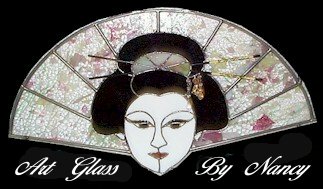


A Little History On Glass
The origins of stained glass are shrouded in mystery, as are the origins of glass itself. The earliest known representation of a stained glass window known as the "Wissembourg Disc” with the head of Christ – goes back only as far as the eleventh century. The art itself probably has its roots in the miniature paintings of Charlemagne’s era; illuminated manuscripts and stained glass windows do have a certain resemblance. But it was during the eleven hundreds that stained glass as an art form came into prominence and by the year twelve hundred, attained a prestige in the religious world that was to haunt the craft for centuries thereafter.
For the Medieval world attached a mystical significance to stained glass. They saw a substance that modifies, shapes, and colors the light passing through it as a parallel to the divine world enhancing the body of man by passing though his spirit. This initial inflection became, in time, a characterization and finally a category which eventually left the art on the backwater of creative thought, as the new forces and ideas came to seek media more adaptable to their expression.
People were not able to read at that time and the medieval windows served to tell the stories of the Bible, Stations of the Cross, Famous Personages of the Church and teaching aids for the populace. The Church used their bishops baptizing or hearing confession as a way to instruct the catechism. Early windows showed very realistic figures and used particularly dark tones and heavy leading to help produce the total effect.
It fell to Louis Comfort Tiffany, son of the famous jeweler, to give stained glass recrudesce. His experiments with pigmentation led to the development of Tiffany glass, a stained glass of color and luminescence that no one before had imagined. A new interest was fired in this ages old art, which began making its appearance in private dwellings. Tiffany was not alone in his researches; both Durand and John LaFarge, both of whom Tiffany had known as creative artists in their own right, were independently seeking the expansion of the basic modality, glass, into the world of art, more especially “Art Nouveau.” But Tiffany led the field among those who insisted that glass must be a strong enough media to stand on it’s own without relying on overlays of painting or other embellishments to sustain it. This is still an uphill fight today, since the Art Field does not always accept stained glass in its avenues of art. The “Art World”, in many cases, relegates Stained Glass to a craft instead of an art. But we are diverting from Louis Comfort Tiffany.
For the Medieval world attached a mystical significance to stained glass. They saw a substance that modifies, shapes, and colors the light passing through it as a parallel to the divine world enhancing the body of man by passing though his spirit. This initial inflection became, in time, a characterization and finally a category which eventually left the art on the backwater of creative thought, as the new forces and ideas came to seek media more adaptable to their expression.
People were not able to read at that time and the medieval windows served to tell the stories of the Bible, Stations of the Cross, Famous Personages of the Church and teaching aids for the populace. The Church used their bishops baptizing or hearing confession as a way to instruct the catechism. Early windows showed very realistic figures and used particularly dark tones and heavy leading to help produce the total effect.
It fell to Louis Comfort Tiffany, son of the famous jeweler, to give stained glass recrudesce. His experiments with pigmentation led to the development of Tiffany glass, a stained glass of color and luminescence that no one before had imagined. A new interest was fired in this ages old art, which began making its appearance in private dwellings. Tiffany was not alone in his researches; both Durand and John LaFarge, both of whom Tiffany had known as creative artists in their own right, were independently seeking the expansion of the basic modality, glass, into the world of art, more especially “Art Nouveau.” But Tiffany led the field among those who insisted that glass must be a strong enough media to stand on it’s own without relying on overlays of painting or other embellishments to sustain it. This is still an uphill fight today, since the Art Field does not always accept stained glass in its avenues of art. The “Art World”, in many cases, relegates Stained Glass to a craft instead of an art. But we are diverting from Louis Comfort Tiffany.
